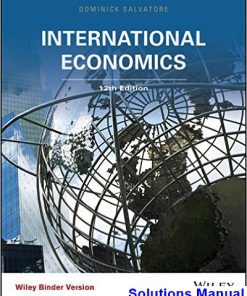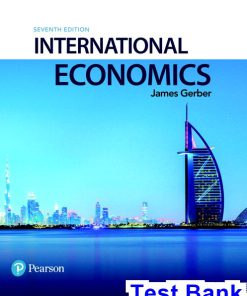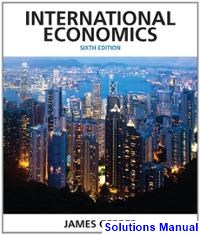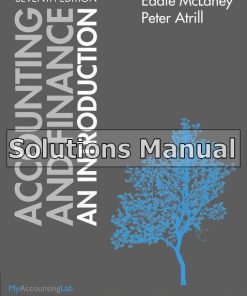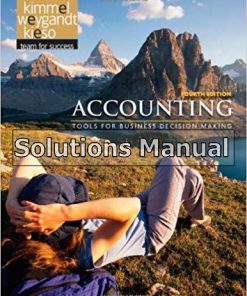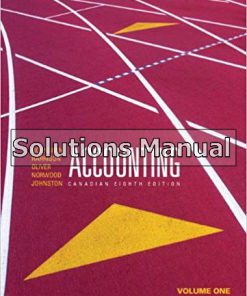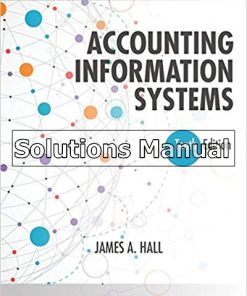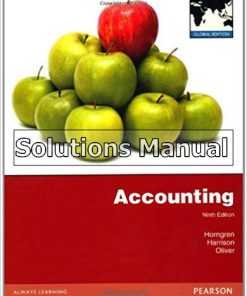International Economics 7th Edition Gerber Solutions Manual
You may also like
This is completed downloadable of International Economics 7th Edition Gerber Solutions Manual
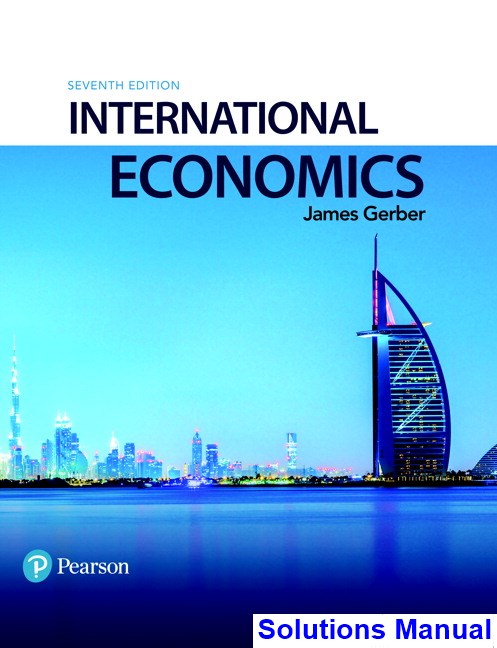
Product Details:
- ISBN-10 : 0134472098
- ISBN-13 : 978-0134472096
- Author: James Gerber
A principles-¿level introduction that’s accessible to readers of all backgrounds, International Economics uses real-life applications to cover both the macro and micro components of international economics. The text illuminates economic institutions and policies, as well as recent developments in the global economy, without requiring the use of higher-¿level math. In addition, the text has a flexible approach, which includes self-¿contained chapters and comprehensive coverage, allowing readers to adapt its concepts to a wide range of possible uses. The 7th Edition includes a number of enhancements, such as updated tables and graphs, new case studies, and revised discussion of relevant topics.
Table of Content:
- PART 1 Introduction and Institutions
- Chapter 1 An Introduction to the World Economy
- Learning Objectives
- Introduction: International Economic Integration
- Elements of International Economic Integration
- The Growth of World Trade
- Capital and Labor Mobility
- Features of Contemporary International Economic Relations
- Deeper Integration
- Multilateral Organizations
- Regional Trade Agreements
- Trade and Economic Growth
- Twelve Themes in International Economics
- The Gains from Trade and New Trade Theory (Chapters 3, 4, and 5)
- Wages, Jobs, and Protection (Chapters 3, 6, 7, and 8)
- Trade Deficits (Chapters 9, 11, and 12)
- Regional Trade Agreements (Chapters 2, 13, and 14)
- The Resolution of Trade Conflicts (Chapters 2, 7, and 8)
- The Role of International Institutions (Chapters 2, 8, and 12)
- Exchange Rates and the Macroeconomy (Chapters 10 and 11)
- Financial Crises and Global Contagion (Chapter 12)
- Capital Flows and the Debt of Developing Countries (Chapters 2, 9, and 12)
- Latin America and the World Economy (Chapter 15)
- Export-Led Growth in East Asia (Chapter 16)
- China and India in the World Economy (Chapter 17)
- Vocabulary
- Study Questions
- Chapter 2 International Economic Institutions Since World War II
- Learning Objectives
- Introduction: International Institutions and Issues Since World War II
- International Institutions
- A Taxonomy of International Economic Institutions
- The IMF, The World Bank, and The WTO
- The IMF and World Bank
- The GATT, the Uruguay Round, and the WTO
- Regional Trade Agreements
- Five Types of Regional Trade Agreements
- Regional Trade Agreements and the WTO
- For and Against RTAs
- The Role of International Economic Institutions
- The Definition of Public Goods
- Maintaining Order and Reducing Uncertainty
- Criticism of International Institutions
- Sovereignty and Transparency
- Ideology
- Implementation and Adjustment Costs
- Summary
- Vocabulary
- Study Questions
- PART 2 International Trade
- Chapter 3 Comparative Advantage and the Gains from Trade
- Learning Objectives
- Introduction: The Gains From Trade
- Adam Smith and the Attack on Economic Nationalism
- A Simple Model of Production and Trade
- Absolute Productivity Advantage and the Gains from Trade
- Comparative Productivity Advantage and The Gains from Trade
- The Production Possibilities Curve
- Relative Prices
- The Consumption Possibilities Curve
- The Gains from Trade
- Domestic Prices and the Trade Price
- Absolute and Comparative Productivity Advantage Contrasted
- Gains From Trade with no Absolute Advantage
- Comparative Advantage and “Competitiveness”
- Economic Restructuring
- Summary
- Vocabulary
- Study Questions
- Chapter 4 Comparative Advantage and Factor Endowments
- Learning Objectives
- Introduction: The Determinants of Comparative Advantage
- Modern Trade Theory
- The HO Trade Model
- Gains from Trade in the HO Model
- Trade and Income Distribution
- The Stolper-Samuelson Theorem
- The Specific Factors Model
- Empirical Tests of the Theory of Comparative Advantage
- Extension of the HO Model
- The Product Cycle
- Foreign Trade versus Foreign Investment
- Off-Shoring and Outsourcing
- Migration and Trade
- The Impact of Trade on Wages and Jobs
- Summary
- Vocabulary
- Study Questions
- Chapter 5 Beyond Comparative Advantage
- Learning Objectives
- Introduction: More Reasons to Trade
- Intraindustry Trade
- Characteristics of Intraindustry Trade
- The Gains from Intraindustry Trade
- Trade and Geography
- Geography, Transportation Costs, and Internal Economics of Scale
- External Economies of Scale
- Trade and External Economies
- Industrial Policy
- Industrial Policies and Market Failure
- Industrial Policy Tools
- Problems with Industrial Policies
- Summary
- Vocabulary
- Study Questions
- Chapter 6 The Theory of Tariffs and Quotas
- Learning Objectives
- Introduction: Tariffs and Quotas
- Analysis of a Tariff
- Consumer and Producer Surplus
- Prices, Output, and Consumption
- Resource Allocation and Income Distribution
- Other Potential Costs
- Retaliation
- Innovation
- Rent Seeking
- The Large Country Case
- Effective Versus Nominal Rates of Protection
- Analysis of Quotas
- Types of Quotas
- The Effect on the Profits of Foreign Producers
- Hidden Forms of Protection
- Summary
- Vocabulary
- Study Questions
- Chapter 7 Commercial Policy
- Learning Objectives
- Introduction: Commercial Policy, Tariffs, and Arguments for Protection
- Tariff Rates in the World’s Major Traders
- The Costs of Protectionism
- The Logic of Collective Action
- Why Nations Protect Their Industries
- Revenue
- The Labor Argument
- The Infant Industry Argument
- The National Security Argument
- The Cultural Protection Argument
- The Retaliation Argument
- The Politics of Protection in the United States
- Antidumping Duties
- Countervailing Duties
- Escape Clause Relief
- Section 301 and Special 301
- Summary
- Vocabulary
- Study Questions
- Chapter 8 International Trade and Labor and Environmental Standards
- Learning Objectives
- Introduction: Income and Standards
- Setting Standards: Harmonization, Mutual Recognition, or Separate?
- Labor Standards
- Defining Labor Standards
- Labor Standards and Trade
- Effectiveness
- Hazy Borderline between Protectionism and Concern
- The Specific Content of Labor Standards
- The Potential to Set Off a Trade War
- Evidence on Low Standards as a Predatory Practice
- Trade and the Environment
- Transboundary and NonTransboundary Effects
- Trade and Environmental Impacts That Do Not Cross Borders
- Trade and Transboundary Environmental Problems
- Alternatives to Trade Measures
- Labels for Exports
- Requiring Home Country Standards
- Increasing International Negotiations
- Summary
- Vocabulary
- Study Questions
- PART 3 International Finance
- Chapter 9 Trade and the Balance of Payments
- Learning Objectives
- Introduction: The Current Account
- The Trade Balance
- The Current and Capital Account Balances
- MyEconLab Real-time Data
- Introduction to the Financial Account
- Types of Financial Flows
- MyEconLab Real-time Data
- Limits on Financial Flows
- The Current Account and the Macroeconomy
- The National Income and Product Accounts
- Are Current Account Deficits Harmful?
- International Debt
- The International Investment Position
- Summary
- Vocabulary
- Study Questions
- APPENDIX A
- Measuring the International Investment Position
- APPENDIX B
- Balance of Payments Data
- Bureau of Economic Analysis
- International Financial Statistics
- Balance of Payments Statistics
- APPENDIX C
- A Note on Numbers
- Chapter 10 Exchange Rates and Exchange Rate Systems
- Learning Objectives
- Introduction: Fixed, Flexible, or In-Between?
- Exchange Rates and Currency Trading
- Reasons for Holding Foreign Currencies
- Institutions
- Exchange Rate Risk
- The Supply and Demand for Foreign Exchange
- Supply and Demand with Flexible Exchange Rates
- Exchange Rates in the Long Run
- Exchange Rates in the Medium Run and Short Run
- The Real Exchange Rate
- Alternatives to Flexible Exchange Rates
- Fixed Exchange Rate Systems
- Choosing the Right Exchange Rate System
- Single Currency Areas
- Conditions for Adopting a Single Currency
- Summary
- Vocabulary
- Study Questions
- APPENDIX
- The Interest Rate Parity Condition
- Chapter 11 An Introduction to Open Economy Macroeconomics
- Learning Objectives
- Introduction: The Macroeconomy in a Global Setting
- Aggregate Demand and Aggregate Supply
- Fiscal and Monetary Policies
- Fiscal Policy
- Monetary Policy
- Current Account Balances Revisited
- Fiscal and Monetary Policies, Interest Rates, and Exchange Rates
- Fiscal and Monetary Policy and the Current Account
- The Long Run
- Macro Policies for Current Account Imbalances
- The Adjustment Process
- Macroeconomic Policy Coordination in Developed Countries
- Summary
- Vocabulary
- Study Questions
- Chapter 12 International Financial Crises
- Learning Objectives
- Introduction: The Challenge to Financial Integration
- Definition of a Financial Crisis
- Vulnerabilities, Triggers, and Contagion
- Vulnerability: Economic Imbalances
- Vulnerability: Volatile Capital Flows
- How Crises Become International: Contagion
- Domestic Issues in Crisis Avoidance
- Moral Hazard and Financial Sector Regulation
- Exchange Rate Policy
- Capital Controls
- Domestic Policies for Crisis Management
- Reform of the International Financial Architecture
- A Lender of Last Resort
- Conditionality
- Reform Urgency
- Summary
- Vocabulary
- Study Questions
- PART 4 Regional Issues in the Global Economy
- Chapter 13 The United States in the World Economy
- Learning Objectives
- Introduction: A Changing World Economy
- Background and Context
- The Shifting Focus of U.S. Trade Relations
- The Nafta Model
- Demographic and Economic Characteristics of North America
- Canada–U.S. Trade Relations
- Mexican Economic Reforms
- The North American Free Trade Agreement
- Two NAFTA-Specific Issues
- New and Old Agreements
- Labor and Environmental Standards
- Investor-State Relations
- Jobs and Trade Agreements
- Summary
- Vocabulary
- Study Questions
- Chapter 14 The European Union: Many Markets into One
- Learning Objectives
- Introduction: The European Union
- The Size of the European Market
- The European Union and ITS Predecessors
- The Treaty of Rome
- Institutional Structure
- EU Institutions and Finance
- Deepening and Widening the Community in the 1970s and 1980s
- Before the Euro
- The Second Wave of Deepening: The Single European Act
- The Delors Report
- Forecasts of the Gains from the Single European Act
- Problems in the Implementation of the SEA
- The Effects of Restructuring
- Harmonization of Technical Standards
- Value-Added Taxes
- Public Procurement
- The Third Wave of Deepening: The Maastricht Treaty
- Monetary Union and the Euro
- Costs and Benefits of Monetary Union
- The Political Economy of the Euro
- Widening the European Union
- New Members
- The Demographic Challenge of the Future
- Summary
- Vocabulary
- Study Questions
- Chapter 15 Trade and Policy Reform in Latin America
- Learning Objectives
- Introduction: Defining a “Latin American” Economy
- Population, Income, and Economic Growth
- Import Substitution Industrialization
- Origins and Goals of ISI
- Criticisms of ISI
- Macroeconomic Instability and Economic Populism
- Populism in Latin America
- The Debt Crisis of The 1980s
- Proximate Causes of the Debt Crisis
- Responses to the Debt Crisis
- Neoliberal Policy Reform and the Washington Consensus
- Stabilization Policies to Control Inflation
- Structural Reform and Open Trade
- The Next Generation of Reforms
- Summary
- Vocabulary
- Study Questions
- Chapter 16 Export-Oriented Growth in East Asia
- Learning Objectives
- Introduction: High-Growth Asian Economies
- Population, Income, and Economic Growth
- A Note on Hong Kong
- General Characteristics of Growth
- Shared Growth
- Rapid Accumulation of Physical and Human Capital
- Rapid Growth of Manufactured Exports
- Stable Macroeconomic Environments
- The Institutional Environment
- Fiscal Discipline and Business–Government Relations
- Avoiding Rent Seeking
- The Role of Industrial Policies
- Targeting Specific Industries
- Did Industrial Policies Work?
- The Role of Manufactured Exports
- The Connections between Growth and Exports
- Is Export Promotion a Good Model for Other Regions?
- Is There an Asian Model of Economic Growth?
- Summary
- Vocabulary
- Study Questions
- Chapter 17 China and India in the World Economy
- Learning Objectives
- Introduction: New Challenges
- Demographic and Economic Characteristics
- Economic Reform in China and India
- The Reform Process in China
- Indian Economic Reforms
- Shifting Comparative Advantages
- China and India in The World Economy
- Chinese and Indian Trade Patterns
- Tariffs and Protection
- Current Account Balances
- Looking Forward
- Four Issues
- Services
- Manufacturing
- Resources
- Multilateral Institutions
- Unresolved Issues
- Environmental Pressures
- State Capitalism
- The Choices Ahead
- Summary
- Vocabulary
- Study Questions
- Glossary
- Index
- A
- B
- C
- D
- E
- F
- G
- H
- I
- J
- K
- L
- M
- N
- O
- P
- Q
- R
- S
- T
- U
- V
- W
- Z
- Practice, Engage, and Assesswith MyEconLab®
People Also Search:
international economics gerber
international economics 7th edition gerber
international economics
international economics 7th edition
international economics 7th edition download scribd
international economics 7th edition solution manual download pdf

